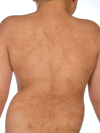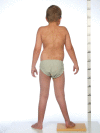Hypomelanosis of Ito presenting with pediatric orthopedic issues: a case report
- PMID: 24886611
- PMCID: PMC4077238
- DOI: 10.1186/1752-1947-8-156
Hypomelanosis of Ito presenting with pediatric orthopedic issues: a case report
Abstract
Introduction: Hypomelanosis of Ito was originally described as a purely cutaneous disease. Extracutaneous manifestations were described later, forming a neurocutaneous syndrome including skeletal, muscular, ocular and central nervous system symptoms.Hypomelanosis of Ito is characterized by a depigmentation along the lines of Blaschko on the trunk and extremities in certain patterns.The aim of this article was to report another case and give an overview of the related orthopedic symptoms that have been previously described. It was also our wish to contribute with recommendations for consideration with regard to bandages on eczematous rashes, especially on clubfeet.
Case presentation: A one-and-a-half-month-old boy of Caucasian background born with talipes equinovarus, or clubfoot, on his right foot presented with an eczematous rash after surgical correction and plaster bandaging.
Conclusions: It is the appearance of hypopigmentation, either alone or in combination with a congenital malformation, particularly central nervous system or musculoskeletal anomalies, which should form the basis of a presumptive diagnosis. This should then lead to further investigations and should always include skin biopsies and a test for chromosomal mosaicism.We report the case of a boy with a clinical picture consisting of a depigmented skin pattern, mental retardation, pes cavus, talipes equinovarus, clinodactyly, eczema, inverted cilia of the eye, strabismus, reduced hearing, ventral hernia, glomerulonephritis, missing testicles, leg length discrepancy with scoliosis, back pain and a syrinx.It is perhaps impossible to make any conclusions about extracutaneous symptoms. However, some symptoms such as retardation, cramps and seizures, delayed development and hypotonia cannot be ignored.Because of the possibility of creating an undesirable and long postoperative period with complications, it is very important to have this diagnosis in mind when deciding to do surgery or not if there are signs of dermatological problems before surgery. In this case, it could also be good clinical practice to test the patient's reaction to plaster or other bandages.
Figures






Similar articles
-
The neurologic aspects of hypomelanosis of Ito: Case report and review of the literature.Sudan J Paediatr. 2014;14(2):61-70. Sudan J Paediatr. 2014. PMID: 27493406 Free PMC article.
-
Hypomelanosis of Ito with a trisomy 2 mosaicism: a case report.J Med Case Rep. 2014 Oct 9;8:333. doi: 10.1186/1752-1947-8-333. J Med Case Rep. 2014. PMID: 25301139 Free PMC article.
-
Hypomelanosis of Ito: clinical syndrome or just phenotype?J Child Neurol. 2000 Oct;15(10):635-44. doi: 10.1177/088307380001501001. J Child Neurol. 2000. PMID: 11063076 Review.
-
[Hypomelanosis of Ito in a girl with Trisomy 13 mosaicism: a cytogenetic study].Ann Dermatol Venereol. 2003 Nov;130(11):1033-8. Ann Dermatol Venereol. 2003. PMID: 14724538 Review. French.
-
Hypomelanosis of ito with trisomy 13 mosaicism [46, XY, der (13;13) (q10;q10), +13/46,xy].Turk J Pediatr. 2002 Apr-Jun;44(2):152-5. Turk J Pediatr. 2002. PMID: 12026206
Cited by
-
Multiple Abnormal Cutaneous Findings in a Patient With Hypomelanosis of Ito Undergoing General Anesthesia.Anesth Prog. 2024 Dec 4;71(4):188-193. doi: 10.2344/23-0025. Anesth Prog. 2024. PMID: 39711452 Free PMC article.
References
Publication types
MeSH terms
LinkOut - more resources
Full Text Sources
Other Literature Sources

